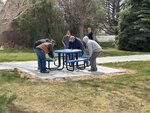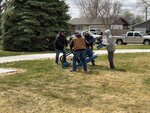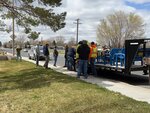


TORRINGTON – For many years, the City of Torrington and the Torrington Rotary Club have joined together to turn a series of tragic events into a special project which many of us in the community enjoy today.
Phase one of this magnificent program began in 1971 when the project, “The Beautiful Coverup,” was promoted as community action to “do something” about the 13-block long open irrigation ditch which ran through the residential portion of town, and further plans for improvements still continue today.
“The Town of Torrington, a community of 4,000 friendly people living in the eastern part of Wyoming, is a thriving agricultural and ranching center. Water is the lifeblood of this semi-arid area, and irrigation canals crisscross the entire countryside. The irrigation canal in question dates back to 1883 when the site of the present town was mostly farmland, and it still serves twenty-three farmers with over 5,000 acres under cultivation – sugar beets, beans corn, and hay,” historical documents read. “As the town grew, Lincoln Land Company, the original owner of most of the farmland, sold off parcels for home sites, retaining right-of-way for the ‘ditch’ property and granting an easement to The New North Platte Irrigation Company for use of the ‘ditch’ for a water carrier. The property, measuring fifty to one hundred feet wide and thirteen city blocks long, became a real problem. Weeds grew man-high in the summer, using valuable water, breeding mosquitoes, catching litter, and providing a fire hazard in winter; but worst of all, the swiftly moving water was a dangerous, attractive nuisance for small children.”
“1969, the project started, the covering project funding through the feds and stuff to cover the ditch. It’s over the New North Platte ditch that used to be an open ditch through tow, irrigation lateral,” Bob Taylor, a member of the Rotary Club and fundamental hands in building the walking path said.
“They got a group together, it was the garden club that got together in ’69, ’70, somewhere in there, they had some issues with some issues with some drownings, some young kids drowning in the ditch,” Dennis Estes, buildings and grounds superintendent for the city said. “So, they got together, and they got a grant and got it covered. It was a lot of volunteer labor. They got it covered all the way over to the swimming pool and it was open after that because there weren’t any houses over there then. Then as they have built houses, they started covering the ditch.”
The open ditch running through town claimed the lives of many area children throughout its open lifespan.
“Three known deaths from ditch drownings and many near escapes. The city had no legal jurisdiction over the whole situation. Various attempts at a solution over the years had failed, so when the Grassroot Gals Garden Club began looking for a project for the 1971-1973 EIP, ‘doing something about the ditch’ was a natural – the biggest challenge in the whole community,” historical documents read.
“New North Platte Ditch Company has an easement in there. The City of Torrington maintains it and pretty much has the land,” Estes said. “It’s still a working ditch, there’s still water in it that comes all the way from the North Platte [River] that comes all the way up the highway through town and goes all the way passed the grade school on the east side of the highway.”
“Probably, basically, ends there,” Taylor nodded.
“Anyway, it was covered by this group in town, and they won an award, won a national award,” Estes said. “I have it in my office. It’s called ‘The Great Cover-Up’ is what they called it. The ditch company takes care of the water, and the city maintains all the property. These partnerships are great for us because we couldn’t do it. We’ve gotten some grants before and did some sections, but these guys helped us a bunch, the Rotary club did. The addition of those benches is really great,” Estes said.
Historical documents provided by Estes, further explain Lincoln Land Company donated the right-of-way property to the town which made it legal for the city to participate in the project. A park bond issue was placed on the ballot and the garden club advocated publicly to get the issue passed.
“They also worked with the city in getting a commitment from the Wyoming Recreation Commission to share 50-50 with the cost of the park development through Federal Bureau of Recreation funds administrated by them. Area farmers and agricultural representatives from the local bank worked with the Agriculture Stabilization & Conservation Service, on a ‘pooling of interests’ agreement to seek Federal Rural Environmental Assistance Program funds granted $40,000. By the end of 1972 the project was ready to go,” the documents explained.
The project was one of five chosen from 50 state winners who competed for five national awards that were presented during the Environmental Improvements Program Council of State Garden Clubs, Inc., in Salt Lake.
“We’ve been involved, Tim (Pieper) had the idea in rotary when he was president as his pet project,” Taylor said. “The rest of the presidents passed him haven’t a pet project and I agreed with Tim, we should keep it going and that’s what we’ve done. This will be we’re going on our fifth-year project; we’ve done four. It’s all grant money from the recreation board. It’s been good.”
“Rotary dumped some money into it as well,” Pieper added.
“The bulk of it came from the recreation board,” Taylor explained. “The Rotary Club has put some money into it. Four projects at $50,000 each year and then we made this, the comprehensive master plan, not just for this but for the future expansion throughout the whole community for that project,” he continued.
The project, Estes, Taylor, and Pieper stressed is ongoing and is part of a community partnership.
“In one of the projects we didn’t do any construction of new walk path, what we did was signage and safety,” Taylor explained. “We did 15 crosswalk crossings where we didn’t have any formal crossings with strips and signs and things, two of which have the button you can push for warnings at main street and east d street. Those are really handy. You can see those a long way off. That same year we did seven, what we call a ‘wayfinding sign’ and there will be seven of them, which tells you where you are at on the path, where it goes so on and so forth. It tells you what facilities are available, bathrooms and whatever,” Taylor added.
Taylor noted, part of the project allowed for the installation of dog waste containers, benches, and tables and according to Taylor, for one year of the project, the main focus was promoting safety.
Estes indicated the path begins behind Torrington High School.
“There used to be an old junky house here for years. I talked the council into buying that. We tore it down and I put all the grass in and the sprinkler system,” Estes said. “We just called it the start of the path. Through the rec board and through some Wyoming Community Gas money I started putting exercise equipment along it in different places.”
Estes explained the path ran to the swimming pool for quite some time, leaving the patch east of the pool uncovered, for a chunk of time.
“The city did this section with grant money,” Estes said as he pointed to a small portion of the path just east of the pool. “Rotary has pretty much done the rest of that.”
Of course, just because the Rotary Club has been working on the path east of the pool, doesn’t mean manhours from city employees aren’t occurred.
“The city helps them out. We go in and get it ready for them,” Estes explained. “They hire contractors.”
“It saves us a lot of money on our contractors,” Taylor added. “We get a lot more bang for the buck. It’s hard for small jobs like that to get contractors even to bid. We bid the projects every year, but we’ve so far hauled three construction projects and only had one proposer. We do enough work with other projects through my firm.”
Pieper also mentions Coby Romig at Baker and Associates has been involved in the feasibility study for the trial.
“He is an engineer and is responsible for most of that feasibility study. The study is required prior to being able to apply for many of the grants available,” Pieper explained.
Taylor mentions every year, Pieper works with Croell, Inc. for a discount on concrete for the projects.
“They’ve been really good to us,” Taylor added. “They deserve a little credit. The school has worked for us. This last segment is on school property behind Trail [Elementary School] and we had to do quite a bit of work on that one. It’s a short segment but we had to move all the fencing because of safety and security reasons for the school so half of the cost of that project was moving the safety fencing and so on and so forth, to keep the kids contained on their property.”
As one could imagine, working on such a large project, over the span of so many years, is challenging from time to time.
“Every project has nuances that you have to deal with and work through every phase of it. You know, working with the city and working with the landowners, it’s been fun, interesting, and a great project,” Taylor said.
Construction and improvements continue, according to the group.
“We have applied for, and we will apply for more for more projects according to this master plan,” Taylor said in terms of grants. “We are in the process; we are going to submit a statement of interest for some grant money. The college, their grant person is helping us a little bit with that and then we’ve got the city to sponsor that for approximately a $1M grant to continue with a significant phase and eventually we’d like to make all of the connections.”
Pieper, who had been sitting quietly while both Estes and Taylor spoke, chimed in, showing the areas which had previously received some form of improvement through the numerous grants. He shared his vision of the future additions to the walking path expressing at some point he envisioned the path to wind down to the North Platte River access point as well as uphill to the college and ball fields.
“Just following along from where Dennis was talking about that it started over there by the high school and just goes through over to main street, connecting at main street. There is the Methodist Church is on the south side of it. Presbyterian is a block north there’s another little church and then it just meanders along and across and diagonals over to Jirdon Park,” Taylor explained. “The swimming pool is right there. There are plans to do other things right there. Rotary is also working on a splash pad project. The final determination in a lot of respects has not been made yet. It’s in an easy phase.”
Pieper said, although the splash pad won’t be part of the path so to speak, it will be close to the path.
“It will be close,” Pieper said. “It will be in the park and the pathway goes around the park, but the splash pad will be in the park.”
Taylor expressed there are always bumps in the road which slows the project down.
“It just follows that ditch right away. There is a large area that’s not developed,” Taylor said.
When Taylor and Pieper were asked how long they felt it would take the entire walking path to be finished, the men laughed.
“We were talking about this the other day when we were talking doing the application for a grant,” Pieper said. “It’s interesting that the first thing that came up is we are getting to the point where we need to redo the part of the path that’s been there since 1970 because it’s not up to code.”
“I didn’t finish that part,” Taylor said. “The million dollars is to upgrade this older portion,” Taylor explained.
“It’s not up to code. For one thing, it needs to be eight feet wide or a minimum of six or whatever,” Pieper said. “It isn’t. The concrete is starting to buckle a little bit. My dream is the first thing we do is a section by the river because I really want to get that done. But everybody else is like we probably should work on the old section.”
More implements continue to be made on the pathway and more project ideas continue to be developed. Even though the pathway is a long process, it is an example of a community working together for a common goal.
“The club spurred community action to develop a workable plan and arrange financing to change the unsightly canal, which was filled with litter, chocked with weeds – not only an eyesore but a dangerous one that had claimed three drowning victims,” a press release announcing the award reads. “As a result of their efforts the irrigation ditch is now a chain of parks with playgrounds and hiking and bicycling paths. The waters that formerly rushed through the ditch are carried in concrete pipe covered by the parkland. It gives proof that a community working together can achieve the near impossible,” the 1970 press release from the Environmental Improvement Program read.